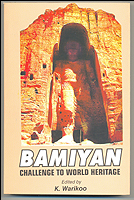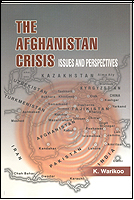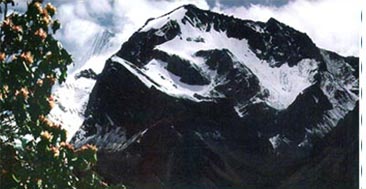14. |
| |
|
GUJJARS of JAMMU AND KASHMIR
By Prof. K. Warikoo
Bhopal, 2001, 317pp.
Content
| 1. |
Gujjars: A Historical Perspective,
Rana Ali
Hasan Chouhan |
1-42 |
| |
|
|
| 2. |
The Origin of Gujjars,
R. P. Khatana |
43-75 |
| |
|
|
| 3. |
Sho’tha Rust’Haveli’s Hero and Heroine,
R.
P. Khatana |
76-83 |
| |
|
|
| 4. |
The Gujjars Over the Centuries,
Masud Choudhary |
84-91 |
| |
|
|
| 5. |
Gojri and its Relationship with Rajasthani,
J. C. Sharma |
92-123 |
| |
|
|
| 6. |
On the Development of Gojri,
Omkar N. Kaul |
124-134 |
| |
|
|
| 7. |
Evolution of Gojri,
Rafique Anjum |
135-144 |
| |
|
|
| 8. |
Spatial Settings,
Abdul Karim Bajran |
145-152 |
| |
|
|
| 9. |
Nomadic Routes in Jammu and Kashmir,
Bansi Dhar |
153-170 |
| |
|
|
| 10. |
Gujjars of Siwaliks: Seasonal Mobility to Sedentarisation,
R.S. Negi |
171-175 |
| |
|
|
| 11. |
Tribal Gujjars of Jammu and Kashmir,
K. Warikoo |
176-205 |
| |
|
|
| 12. |
Quest for Gujar Identity,
Balraj Puri |
206-210 |
| |
|
|
| 13. |
Travails of the Gujjars,
Hari Om |
211-236 |
| |
|
|
| 14. |
The Nomadic Gujjars: Love, Family Honour and the Community,
Pervez Dewan |
237-244 |
| |
|
|
| 15. |
Gujjars of Kashmir Valley: Habitat and Lifestyle,
Naeem
Akhtar |
245-252 |
| |
|
|
| 16. |
Gujjars and Bakarwals of Jammu and Kashmir: A Case Study
of Rajouri,
Bupinder Zutshi |
253-285 |
| |
|
|
| 17. |
Gujjar-Bakarwals of Jammu and Kashmir: Problems of Socialisation
and Education, M.L. Raina |
286-296 |
| |
|
|
| |
Appendices |
297-306 |
| |
|
|
| |
Index |
307-317 |
| |
|
|
|
 |
|
15. |
| |
 |
BAMIYAN : CHALLENGE TO WORLD HERITAGE
Edited by Prof. K. Warikoo
New Delhi, Bhavana Books and Prints, 2002. xvii, 313pp. 61 photos
Content
| 1. |
Bamiyan and the Buddhist Art of Colossi
Lokesh Chandra |
0-10 |
| |
|
|
| 2. |
Bamiyan in an Art Historical Perspective
Subhashini Aryan |
11-32 |
| |
|
|
| 3. |
The Meaning and Function of Bamiyan in the 7th-8th Centuries,
Deborah Klimburg Salter |
33-39 |
| |
|
|
| 4. |
Buddhist Heritage of Central Asia: Problems of Study and Conservation,
Valentina
Goryacheva |
40-56 |
| |
|
|
| 5. |
Religio-cultural links of Afghanistan and Western Himalaya,
O.C. Handa |
57-74 |
| |
|
|
| 6. |
Looking Back in Time : Historical, Cultural and Artistic Links
between Ancient Kashmir and Afghanistan,
S.S. Toshkhani |
75-88 |
| |
|
|
| 7. |
Ambaran- A Gandharan Outpost in Shivaliks,
Lalit Gupta |
89-94 |
| |
|
|
| 8. |
Buddhist Art from the Northwest to the Far East,
Shashibala |
95-103 |
| |
|
|
| 9. |
World Heritage and Culture of Peace and Harmony,
D.S.
Uchida |
104-111 |
| |
|
|
| 10. |
Bamiyan Demolition,
Sumana Siri |
112-121 |
| |
|
|
| 11. |
The Bamiyan Buddhas, the Taliban and Islam,
Kalim Bahadur |
122-141 |
| |
|
|
| 12. |
Religion and Politics in Afghanistan: The Role of Taliban Regime
Smruti S. Pattanaik |
142-149 |
| |
|
|
| 13. |
Preservation and Restoration of Buddha Colossi at Bamiyan in
Afghanistan by India,
R. Sengupta |
150-155 |
| |
|
|
| 14.. |
UNESCO's Response to the Destruction of the Statues in Bamiyan,
Christian Manhart |
156-163 |
| |
|
|
| 15. |
Protection and Restitution of Afghan Cultural Heritage in the
Framework of the Afghanistan-Museum in Exile,
Paul Bucherer
Dietschi |
164-183 |
| |
|
|
| 16. |
Cultural Preservation and the Challenge of Globalization,
Richard
Mac Phail |
184-195 |
| |
|
|
| 17. |
The Tragedy of Bamiyan: Necessity and Limits of the Dialogue
of Religions and Cultures,
M. Darrol Bryant |
196-225 |
| |
|
|
| 18. |
Bamiyan Buddhas and International Law,
V.S. Mani |
226-229 |
| |
|
|
| 19. |
The Buddhas of Bamiyan and Beyond: The Quest for an Effective
Protection of Cultural Property,
Juliette van Krieken-Pieters |
230 |
| |
|
|
| 20. |
Appendices |
|
| |
|
|
|
 |
|
16. |
| |
 |
THE AFGHANISTAN CRISIS : ISSUES AND PERSPECTIVES
Edited by Prof. K. Warikoo
Content
| 1. |
Afghanistan and India: Historico-Cultural Perspective,
Lokesh
Chandra |
0-15 |
| |
|
|
| 2. |
Ethnicity and Politics in Afghanistan Manmath,
Narayan
Singh |
16-46 |
| |
|
|
| 3. |
Afghanistan and the Quest for Central Asian Resources,
Frederic
Grare |
47-61 |
| |
|
|
| 4. |
The Afghan Conundrum: Light Weapons and State Collapse,
Ajay Darshan Behera |
62-82 |
| |
|
|
| 5. |
Refugee Situation in Afghanistan,
Yehya Maroofi |
83-98 |
| |
|
|
| 6. |
Position of Women in Afghanistan,
Arpita Basu Roy |
99-117 |
| |
|
|
| 7. |
The Taliban View of Jihad and the Islamic Precepts,
Sultan
Shahin |
118-134 |
| |
|
|
| 8. |
The Taliban Phenomenon and the Security Environment,
Afsir
Karim |
135-143 |
| |
|
|
| 9. |
The Pakistan-Afghanistan Cauldron: The Global Perspective,
Vinod
Saighal |
144-159 |
| |
|
|
| 10. |
Afghanistan: Source of Religious Extremism and Terrorism for
Central Asia,
A. A. Knyazev |
160-184 |
| |
|
|
| 11. |
The Taliban Phenomenon: Regional Security Implications for Central
Asia,
Leonid Kusmenovich Bakayev |
185-198 |
| |
|
|
| 12. |
Afghanistan Problem: Russian and Central Asian Response,
Devendra
Kaushik |
199-210 |
| |
|
|
| 13. |
Afghanistan and Cross-border Terrorism in the CIS,
Mahendra
Ved |
211-230 |
| |
|
|
| 14.. |
An International Approach to Afghanistan’s Future,
Marvin
Weinbaum |
231-244 |
| |
|
|
| 15. |
The Role of Outside Actors in Afghanistan,
Amin Saikal |
245-255 |
| |
|
|
| 16. |
Confronting Creeping Invasions: Afghanistan, the UN and the
World Community,
William Maley |
256-274 |
| |
|
|
| 17. |
Taliban and External Powers,
Sreedhar |
275-289 |
| |
|
|
| 18. |
United States, Taliban and Crisis in Afghanistan,
B.K.
Srivastava |
290-309 |
| |
|
|
| 19. |
United Nations and the Afghanistan situation: The Taliban Era,
C.S.R. Murthy |
310-332 |
| |
|
|
| 20. |
Pakistan’s Policy in Afghanistan,
Kalim Bahadur |
333-350 |
| |
|
|
| 21. |
Pakistan-Afghan Relations, 1994-2000,
Mutahir Ahmed |
351-381 |
| |
|
|
| 22. |
Shadow of Afghanistan over Kashmir,
K. Warikoo |
382-391 |
| |
|
|
| 23.. |
China’s Afghan Policy: Limitations versus Leverages,
Swaran
Singh |
392-405 |
| |
|
|
| 24. |
Iran and Afghanistan: Conflict of Strategic Interest and Perception,
Smruti S. Pattanaik |
406 |
| |
|
|
| 25. |
Osama bin Laden, International Terrorism and Afghanistan,
Savita
Pandey |
|
| |
|
|
|
 |
|
17. |
| |
 |
MONGOLIA - INDIA RELATIONS
By Oidov Nyamdavaa
New Delhi, Bhavana Books & Prints, 2003, 228pp.
Content
| Part I: Historico-Cultural Linkages |
1 |
| 1. |
Historical Contacts |
1 |
| |
(a) |
Hungnu-India |
1 |
| |
|
(i) |
The Hunas |
4 |
| |
|
(ii) |
Impact of Hunas' Invasion |
5 |
| |
(b) |
Post-Chinggis Khan Period and India |
6 |
| |
(c) |
Mongol Edifices and their Importance |
8 |
| |
|
(i) |
Mongolpuri in New Delhi |
8 |
| |
|
(ii) |
Siri Fort and Chor Minar in New Delhi |
10 |
| |
(d) |
Tracing the Meaning of Mughal |
11 |
| |
|
|
| 2. |
Buddhist Ties |
14 |
| |
(a) |
Spread of Buddhism in Mongolia |
14 |
| |
(b) |
Buddhist Influence on Mongolia |
19 |
| |
|
|
| 3. |
Culture and Literary Links |
21 |
| |
|
|
| 4. |
Traditional Medicine Link |
29 |
| |
|
|
| 5. |
Mongols in India and their Spatial Pattern |
30 |
| |
|
|
| 6. |
Linguistic Affinities |
33 |
| |
|
|
| Part II: Political Relations |
43 |
| 1. |
Mongolia's Foreign Relations: An Overview |
43 |
| |
|
|
| 2. |
Mongolia's New Foreign Policy Perspectives and Initiatives |
46 |
| |
|
|
| 3. |
Mongolia-India Ties |
50 |
| |
|
(i) |
The Establishment of Diplomatic Relations |
58 |
| |
|
(ii) |
Broadening Political Relations (1970-1990) |
61 |
| |
|
(iii) |
Enhanced Co-operation (1991-2002) |
66 |
| |
|
|
| 4. |
Mongolia and India - Spiritual Neighbours |
72 |
| |
|
|
| Part III: Mongolia-Indian Economic Cooperation (1949-2002) |
|
| 1. |
Economic Situation in Mongolia |
79 |
| |
(a) |
Foreign Participation in Key Sectors |
83 |
| |
|
|
| 2. |
Potential for Economic Development and Cooperation |
83 |
| |
|
|
| 3. |
Mongolia-India Development Cooperation and Partnership |
97 |
| |
|
|
| 4. |
The Jont Efforts to Promote and Encourage Mongolian-Indian
Trade and Economic Cooperation Since 1990s |
105 |
| |
|
|
| 5. |
Indian Consortium to build Mongolian Highway |
109 |
| |
|
|
| Part IV: Rejuvenating Cultural Contacts |
114 |
| 1. |
Cultural Exchange |
114 |
| |
|
|
| 2. |
Enrichment of Literary Links |
119 |
| |
|
|
| 3. |
Present situation of Buddhism in Mongolia
Conclusion |
127 |
| |
|
|
| |
Appendices |
131 |
| |
|
|
| |
Genealogy of the Mongols |
|
| |
|
|
| |
Bibliography |
|
| |
|
|
| |
Index |
|
| |
|
|
| |
|
|
|
 |
|
18. |
| |
 |
CHILD LABOUR REHABILITATION IN INDIA
Edited by Dr. B. Zutshi and Dr. M. Dutta
Content
| 1. |
Child Labour: A Resume,
L. Mishra |
| |
|
| 2. |
Child Labour: Contemporary Realities,
M.N. Venkatachaliah |
| |
|
| 3. |
Child Labour Issues and Rehabilitation: A Thematic Presentation,
Kailash Satyarthi |
| |
|
| 4. |
Approaches Towards Combating Child Labour,
C.J. George,
Terre Des Hommes |
| |
|
| 5. |
Conceptual Narratives in Human Rights of the Child Discourse
in Developing Countries,
I.P. Massey |
| |
|
| 6. |
Magnitude of Child Labour with Special REference to Girl Child:
An Indian Scenario,
Mondira Dutta |
| |
|
| 7. |
Primary Education to Eradicate Child Labour,
P. D. Mathews
S. J. |
| |
|
| 8. |
Child Labour and the Interpretation of Article 45 of the Indian
Constitution,
R. M. Pal |
| |
|
| 9. |
Child Labour Rehabilitation and Non-Formal Education,
P.Das
Gupta |
| |
|
| 10. |
Child Labour: NGOs Experiences,
Ramakant Rai and Kuldeep Narain Maurya |
| |
|
| 11. |
A Strategy for Rehabilitation of Working Children in Carpet
Industry in Uttar Pradesh, India.
Robin Garland and David Rangpal |
| |
|
| 12. |
An Overview of International Programme on Elimination of Child
Labour (IPEC) Programmes in India.
R.K. Khurana |
| |
|
| 13. |
Reha Programmes and Issues on the Rehabilitation of the Carpet
Children,
Geeta Singh |
| |
|
| 14. |
Alternative Learning a Child Child-Responsive and Community, Bhadhoi-Mirzapur Experiences,
The UNICEF Approach:
Bal Adhikar Pariyojana |
| |
|
| 15. |
RUGMARK: Campaign against Child Labour,
S. Sondhi |
| |
|
| 16. |
Child Labour Rehabilitation Programmes: Experiences of PEACE
TRUST, Tamil Nadu.
J. Paul Baskar |
| |
|
| 17. |
Overview of Carpet export promotion Council,
T.S. Chadha |
| |
|
| 18. |
Impact of Rehabilitation Programmes on Child Labour,
Helen
R. Sekar |
| |
|
| 19. |
Child Labour Rehabilitation in India: A Case Study of Mirzapur-Bhadhoi
Carpet Weaving Belt,
Bupinder Zutshi |
| |
|
| 20. |
Appendix: Recommendations for Rehabilitation of released
Children from work
Index |
| |
|
|
 |
|
| |
 |
|


